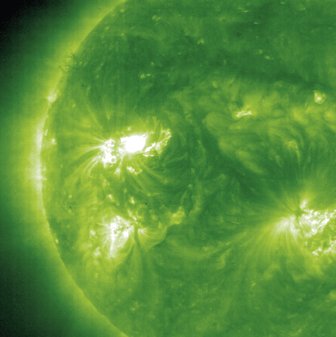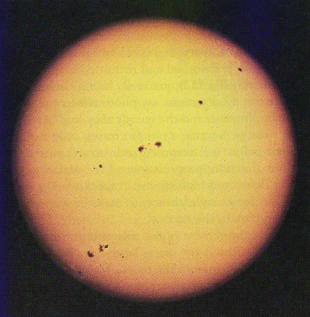Predicting Solar Storms
Violent activity at and near the sun's surface produces giant storms that can affect Earth.
By Emily Sohn
The sun is a lot more than a giant ball of hot gas. Its surface is speckled with dark spots and roiled by energy-packed storms that shoot out massive clouds of charged particles and magnetic fields.
Predicting when such solar storms occur is important because magnetic eruptions on the sun can knock out power grids on Earth and interfere with satellites orbiting the planet. Knowing that storms are coming could help us better prepare for them.
 |
|
This large, active region of the sun (bright spot, upper left) is more than 20 times the size of Earth. A new computer model predicts that the next period of intense solar activity won’t begin until late 2008, about a year later than the standard, 11-year cycle would forecast. |
| SOHO, ESA, NASA |
There isn’t a lot happening on the sun right now, but scientists have long known that the amount of activity on the sun rises and falls in a cycle that lasts about 11 years. We’re at a lull before activity ramps up again.
A new computer model is helping scientists forecast how strong future solar storms will be and how often they will occur. The model predicts that the next solar cycle will begin a year later than the timing of the standard 11-year cycle would suggest. Once it starts, it’ll be 30 to 50 percent more intense than the cycle that we’re in right now.
Researchers from the National Center for Atmospheric Research in Boulder, Colo., based the new model on observations of electrically charged gas, called plasma, that flows across the surface of the sun and through its fiery insides.
As the plasma moves, it carries magnetic fields than join together and break apart. Sometimes, these fields release huge amounts of energy from within a sunspot, creating storms.
 |
|
Sunspots are dark regions of the sun where magnetic fields concentrate and release enormous amounts of energy.
|
| NASA |
There are two types of plasma motion that determine the solar cycle of storms. The rotation of the sun, first of all, causes plasma at the poles to rotate faster than plasma at the equator. This causes the sun’s magnetic fields to stretch and twist, which releases energy.
Secondly, plasma at the equator moves to the poles as if it were on a conveyer belt. Then, the charged gas plunges toward the sun’s center, before returning to the surface. When it bursts back out, it also releases energy.
The new model shows that the plasma’s motion has slowed down over the last few decades. This suggests that the next cycle will begin slightly late. Storm activity should begin building in late 2008 and peak around 2012.
Tests of the new model have shown that it matches the timing of previous solar cycles. Still, it’s not the only model available, and different models disagree over the timing and strength of what’s to come. When the next cycle hits in a few years, scientists will have a better handle on which model to trust.—E. Sohn
Going Deeper:
Cowen, Ron. 2006. Magnetic memory: New model forecasts solar storms. Science News 169(March 11):147. Available at http://www.sciencenews.org/articles/20060311/fob1.asp .
You can learn more about the new computer model for predicting solar cycles at www.nasa.gov/home/hqnews/2006/mar/HQ_06087_solar_cycle.html (NASA).
Movies showing solar storms can be found at www.nasa.gov/vision/universe/solarsystem/solar_cycle_graphics.html (NASA).
Information about the current solar cycle can be found at science.nasa.gov/headlines/y2004/18oct_solarminimum.htm (NASA).







